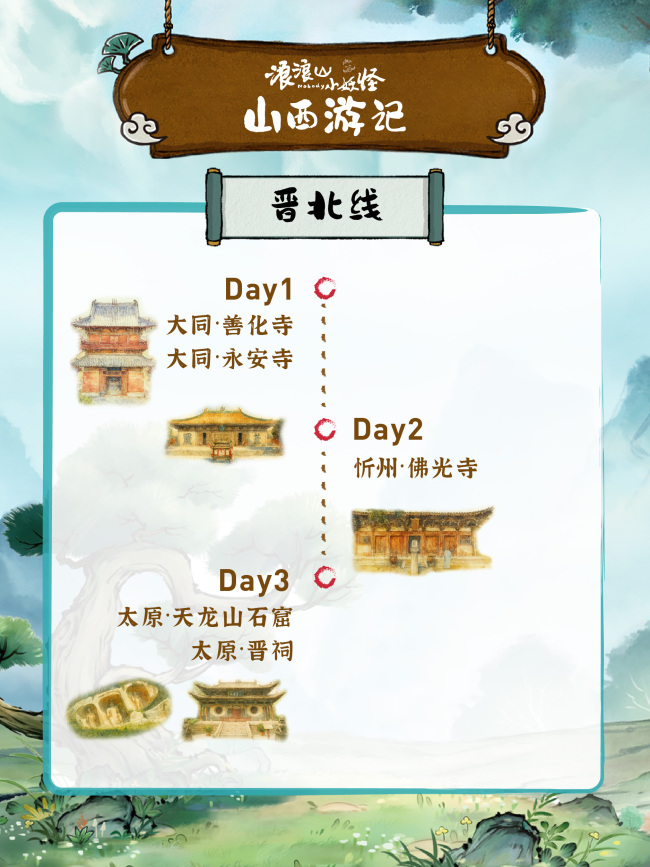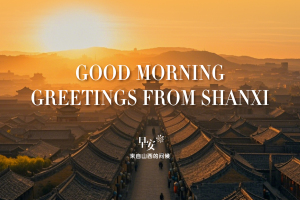Following the Little Monsters of Langlang Mountain on a Tour of Shanxi — Northern Shanxi Route (Part 1)

今年夏天,动画《浪浪山小妖怪》中以“像极了普通人”的真诚形象走红的一群小妖怪,带领观众走进了一段充满烟火气与古建魅力的“取经路”。山西文旅特别推出一南一北两条主题旅游路线,本期将带你沿着晋北线,与小妖怪一同探访那些承载历史与传说的千年古刹。
In the summer of this year, the vibrant little monsters from Nobody won over countless fans with their relatable struggles and hopes. Their “journey to the west” beautifully intertwines with the rustic charm and ancient architectural soul of Shanxi. To offer travelers an in-depth experience of this “little monsters’ pilgrimage,” Shanxi Culture and Tourism has launched two exclusive treasure-hunting routes—one in the south and one in the north. Today, let’s follow the little monsters and explore the allure of northern Shanxi together.

大同善化寺
Shanhua Temple (Datong)
善化寺的山门殿内,明代四大天王彩塑威严庄重、细腻生动,在电影中被赋予“守护结界”的使命,也因此被观众亲切称为“最萌四大天王”。四大天王手执宝剑、琵琶、伞与蛇,象征“风调雨顺”,不仅寓意吉祥,更让这座辽金时期的古寺焕发新的生命力。
Inside the mountain gate hall of Shanhua Temple, the vividly sculpted Ming Dynasty statues of the Four Heavenly Kings have become a popular spot for visitors. These majestic and exquisitely detailed figures, tasked in the film with “guarding the boundary,” are now affectionately called “the cutest Four Heavenly Kings” by fans. Holding a sword, lute, umbrella, and snake respectively, they symbolize “favorable weather and peace,” adding a layer of cultural meaning to this ancient Liao and Jin dynasty temple.

浑源永安寺
Yong'an Temple (Hunyuan)
小妖怪取经路上的“第一难”,正是在这座寺中展开——帮助村民驱赶老鼠精。永安寺,又名永安禅寺,位于大同浑源县,始建于金代,后于元代重建。寺内两侧墙上“庄严”二字为元代住持月溪和尚所书,字高达四米,笔力雄浑,与大殿相映成辉,气势恢宏。
The little monsters encounter their “first trial” on their journey — helping villagers capture a rat spirit that had taken over a temple. Does the word “solemn” on the temple walls look familiar? Yes, this temple is none other than Yong’an Temple in Hunyuan County, Datong. Originally built during the Jin Dynasty and later reconstructed in the Yuan Dynasty, the temple complex is a well-pres example of Yuan architecture. The Chinese characters for “solemn,” nearly four meters high and written by Abbot Yuexi of the Yuan Dynasty, stand powerfully on both sides of the wall, enhancing the grandeur of the main hall.
Window of Shanxi
-

Significant Achievements in Shanxi’s Opening-Up During the “14th Five-Year Plan” Period
-

Savoring Antiquity in Winter Shanxi
-

A Bite of Autumn,How Delicious is Autumn in Shanxi?
-

Good Morning Greetings From Shanxi
-

Roaming Shanxi An Encounter with Autumn Hues
Trending News
-

Shanxi’s 8th Appearance at CIIE: Openness and Vitality on the Global Stage
-

9th Pingyao International Film Festival Grand Opening
-

2025 Shanxi Cultural and Tourism Development Promotion Event Concludes Successfully
-

"Shanxi Meets the World" Exchange Event for Tourism and Leisure Cities Successfully Held
-

The 7th Shanxi Cultural Industries Fair Successfully Concludes: Technology Empowers Culture, Innovation Leads the Future